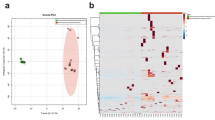Summary
Free and matrix-bound phosphophoryns, both highly phosphorylated proteins in dentin, were prepared from EDTA extract and CNBr-digests of bovine dentin. The two components were purified by DEAE-cellulose, SP-Sephadex, and gel filtration chromatography. The matrix-bound component was eluted as a distinct peak from the free component in the above chromatographic systems. Amino acid composition of the purified matrixbound component indicated that this component consisted of phosphophoryn and collagen in the ratio of 2:3 based on the number of the residues. The matrix-bound component could not be reconstituted by mixing phosphophoryn with collagen CNBr peptides. Artificial crosslink products of free phosphophoryn and collagen CNBr-peptides by the carbodiimide method showed similar properties to the physiological matrix-bound phosphophoryn. The bond between phosphophoryn and collagen of the matrix-bound component is assumed to be a covalent crosslink.
Similar content being viewed by others
References
Dimuzio MT, Veis A (1978) Phosphophoryns-major non-collagenous proteins of rat incisor dentin. Calcif Tissue Res 25:169–178
Carmichael DJ, Veis A, Wang ET (1971) Dentin matrix collagen: evidence for a covalently linked phosphoprotein attachment. Calcif Tissue Res 7:331–344
Curley-Joseph J, Veis A (1979) The nature of covalent complexes of phosphoproteins with collagen in the bovine dentin matrix. J Dent Res 58:1625–1633
Lee SL, Veis A (1980) Studies on the structure and chemistry of dentin collagen-phosphophoryn covalent complexes. Calcif Tissue Int 31:123–134
Fujisawa R, Takagi T, Kuboki Y, Sasaki S (1981) The characterization of collagen-phosphophoryn complex in bovine dentin. In: Veis A (ed) The chemistry and biology of mineralized connective tissues. Elsevier/North-Holland, New York, p 483
Linde A, Bhown M, Butler WT (1981) Non-collagenous proteins of rat dentin. Evidence that phosphoprotein is not covalently bound to collagen. Biochim Biophys Acta 667:341–350
Kuboki Y, Fujisawa R, Aoyama K, Sasaki S (1979) Calciumspecific precipitation of dentin phosphoprotein: a new method of purification and the significance for the mechanism of calcification. J Dent Res 58:1926–1932
Munksgaard EC, Butler WT, Richardson WS (1977) Phosphoprotein from dentin. New approaches to achieve and assess purity. Prep Biochem 7:321–331.
Hoare DG, Koshland DE, Jr. (1967) A method for the quantitative modification and estimation of carboxylic acid groups in proteins. J Biol Chem 242:2447–2453
Fujimoto D, Hirama M, Iwashita T (1981) Occurrence of lysinoalanine in calcified tissue collagen. Biochem Biophys Res Commun 103:1378–1383
Sternberg M, Kim CY (1977) Lysinoalanine formation in protein food ingredients. In: Friedman M (ed) Protein crosslinking. Plenum Press, New York, p 73
Author information
Authors and Affiliations
Rights and permissions
About this article
Cite this article
Fujisawa, R., Takagi, T., Kuboki, Y. et al. Systematic purification of free and matrix-bound phosphophoryns of bovine dentin: Presence of matrix-bound phosphophoryn as a distinct molecular entity. Calcif Tissue Int 36, 239–242 (1984). https://doi.org/10.1007/BF02405323
Received:
Accepted:
Issue Date:
DOI: https://doi.org/10.1007/BF02405323




